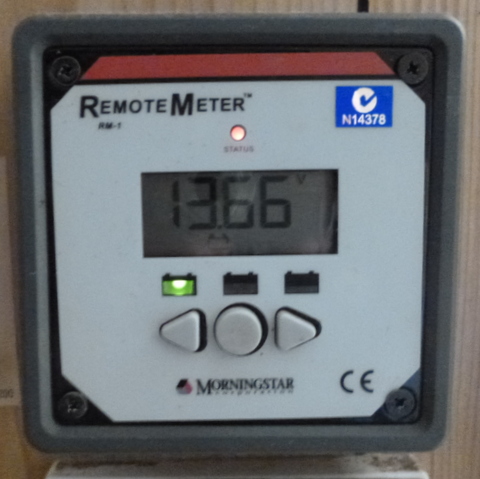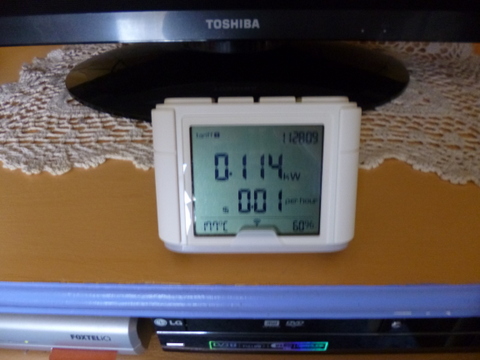What you don’t measure, you don’t control
I have said it before, but I am a fan of the saying by Edwards Demming, darling of the quality assurance set, “what you don’t measure, you don’t control”. I not only am a fan, but I try to put it into practice where I can.
There a number of ways where we have found where measuring something on a regular (or irregular for that matter) basis can keep us on track towards where we want to be, living more sustainably and resiliently. There is the big picture stuff which helps us monitor where we are on the large scale, like the Sustainable Lifestyle Assessment Matrix (SLAM) I developed and we used to kick things off. This was followed by the more detailed item specific audits for each of the sections in the SLAM eg, energy, water, waste, food, transport etc. This provided lots of detail for setting up our plans, but there is also the low level, day to day stuff which keeps us on track on the smaller scale.
Some of these things include –
Gauges – these help us to keep a handle on our energy output and consumption. We used to monitor the batteries on the old system, do monitor the batteries on the new system and the electricity consumption on the new system. We also have a gauge which monitors our consumption of electricity from the grid. It shows zero most of the time but allows us to check how much electricity we are using when we need back up for the off grid system after some cloudy days.
The one thing they all have in common is that they are not hidden away in a cupboard somewhere, they are out in the open where they can be checked on a regular basis. By checking them regularly throughout the day, just with a glance, you get used to the sorts of readings you should be getting and if something is out of the ordinary you can pick it up and action it quickly. This feature saved us from killing our 12volt lead acid batteries on a number of occasions where something had gone wrong, even a loose wire that could have caused problems when it came time to turn on the lights that night.
Our new system goes one step further and there is an ap on my phone (I know!) which I can use to monitor how much energy the panels are producing and what the battery charge levels are like from minute to minute. This was especially important when I was getting used to the new system and a mistake could mean that it shut down and we would have to switch back to the grid, but it does help us monitor how much electricity we produce vs how much we use.
Bills – OK, so nobody likes bills, but when it comes to energy bills and water bills, as unpalatable as the may be, they also contain important information on the consumption of both commodities. If your electricity all comes from the grid and you don’t want to pay for an extra monitor, the bill is your best source of information. For electricity, gas and water the bill may tell you –
- How much power/water you used over the last 3 months as an aggregate figure
- How your consumption for that quarter compares with the previous quarter and the same quarter the previous year
- How your consumption compares with other average figures for consumption, depending on the number of people in your household.
This can be hugely important information if you are working to reduce your consumption of water, power or both and is the final report card on how your efforts are coming along. It can also, particularly in terms of water, point out that you have an undiscovered leak if the numbers show a sudden and unexpected jump, or are going up when they should be coming down.



Small scale reviews or audits – These are information gathering exercises carried out over time to provide data on a small part of our life, to highlight where we are doing well (so we can do it more) and where we are doing poorly (so we can focus on improving). An example of this is an exercise I carried out recently looking at the food we buy.
I have a fair idea of the sorts and amounts of food which we buy in general, but there is no substitute for measuring and for recording the data. We have a supermarket, greengrocer and butcher within walking distance and to save transport energy these tend to be our go-to (for more discussion on this very point, see The Corn Conundrum).
I wanted to know what we were spending so I could see what opportunities there were for –
- Home production
- Bulk buying
- Substituting from other sources.
First I set the criteria for the audit. It would cover food purchases from the supermarket and green grocer and to a lesser extent, butcher which we have been using less and less as we move towards a plant based diet. It did not include: takeaway (traditional on a Friday night) or bulk purchases like a 25kg of rolled oats and skim milk powder ($90 and $120 respectively) which occurred during the time of the audit.
To help me record the data I was generating I put together a (very) simple Excel spreadsheet. Excel spreadsheets also have a ‘sort’ function which helps me to analyse the data by grouping together purchases of similar products over time. The headings I used for the grocery sheet was -
Date – so that I had an idea of the time that items I purchased regularly would last before they needed to be rebought.
Item – this one is important to get right and by that I mean to use the same item name each time they are entered on the spreadsheet. If an item is entered as ‘baked beans’ initially then ‘beans, baked’ when bought next and then as ‘Fred’s Baked Beans’ a third time it makes sorting for analysis very difficult. Entering each item under the same name each time means they will group together when sorted. Simple I know but it easy to make a mistake……. Or so I’ve heard!
Size – how many grams, kilos or litres of each product is bought at a time, which can give you a feeling for how much of each product is bought over the time of the audit, and can then be extrapolated over a month, 6 months or year or whatever. Thus you can hit the high use stuff first.
Number – This is just there so that when I bought multiples of the same item, I didn’t have to enter each one separately, but I would still be able to work out the total numbers of that item over the period being measured.
Total cost – how much each item (or number of items) cost all up to give me an idea of how much I was spending over time. This column could be aggregated to give me a total spend during the audit timeframe.
I then put together as similar sheet for Fruit and Veg, and meat. If you want a blank copy to model your own on, it can be downloaded here.
To operate the audit was a fairly simple matter. Every time I made a purchase within the criteria I had set out I made sure to get the receipt and then as soon as I got home (mostly, alright I saved them up until the end of the week!) entered the data for each one into the spreadsheet. I did this for a period of four months, but you could do it for as long or short as you like, bearing in mind that the longer it goes on for, the more information it will yield.
After four months I sat down and did a bit of analysis, the easiest way to do that (for me) was to sort for item name so that the items were aggregated, and it turns out over that 4 months we bought –
- 9 tins of sliced beetroot, total weight 7.5kg for a bit over $21 (could be home produced and/or preserved)
- 26 tins of sliced peaches (in juice), total weight 21.5kg for $80.65 (no way to grow at our place but could be bought in bulk in season and home preserved)
- 16 x 750g loaves of bread for $76 (home baking)
- All up $746 worth of groceries, $260 worth of F&V and $10 worth of preserved meats for homemade pizza (we did have some meat in the freezer we were working through to use up).
- Not too bad for a family of 2 for four months I think!
It depends on what is important to you and what your big ticket items are in your journey towards living a sustainable life, but whatever they are decide what you need to measure to control them, and then do it!







